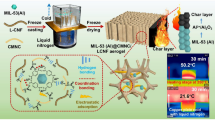The feasibility of use of natural nanomaterials, namely, natural aluminosilicate (halloysite) nanotubes and nanocellulose, as modifying additives to commercial polyurethane foam to vary fire resistance and mechanical properties was studied. Series of composite polyurethane foams containing various weight proportions of the modifying additives were obtained via in situ polymerization. The effect of the additives on the polyurethane foam structure, compressibility, and fire resistance was studied. It was observed that introduction of additives into polyurethane foam leads to change of the average pore size and reduction of foams compressibility. However, once the the maximum rigidity of the foam composites was reached, further increase of additive content causes regression of this characteristic. It was also confirmed that increasing additive content positively affects the fire resistance of the produced composites.


Similar content being viewed by others
References
M. Ionescu, Chemistry and Technology of Polyols for Polyurethanes, Rapra Technology Limited, Shawbury, UK (2005).
K. Cherednichenko, D. Kopitsyn, E. Smirnov, et al., Polymers, 15(10), p. 2314.
C. Liang, U.R. Gracida-Alvarez, E.T. Gallant, et al., Environmental Science & Technology, 55(20), 14215-14224 (2021).
G. Oertel, Polyurethane Handbook, Hanser Publishers, Munich (1993).
N.V. Gama, A. Ferreira, and A. Barros-Timmons, Materials, 11(10), 1841 (2018).
A. Kausar, Polym. Plast. Technol. Eng., 57, 346–369 (2018).
S.V. Levchik and E.D. Weil, Polym. Int., 53, 1585–1610 (2004).
D.K. Chattopadhyay and D.C. Webster, Prog. Polym. Sci., 34, 1068–1133 (2009).
P.M. Visakh, A.O. Semkin, I.A. Rezaev, et al., Constr. Build. Mater., 227, 116673 (2019).
H. Yang, B. Yu, P. Song, et al., Compos, Part B Eng., 176, 107185 (2019).
M. Zhu, Z. Ma, L. Liu, et al., J. Mater. Sci. Technol., 112, 315–328 (2022).
A. Dasari, Z.-Z. Yu, G.-P. Cai, et al., Prog. Polym. Sci., 38, 1357 (2013).
F. Yang, M. Xie, Z. Yudi, et al., Cell. Polym., 40, 165–179 (2021).
H. Pan, Y. Pan, W. Wang, et al., Ind. Eng. Chem. Res., 53, 14315 (2014).
A. Agrawal, R. Kaur, R.S. Walia, Fire Mater., 43, 917–927 (2019).
A. Fahami, J. Lee, S. Lazar, et al., ACS Appl. Mater. Interfaces, 12, 19938–19943 (2020).
S. Lazar, F. Carosio, A.-L. Davesne, et al., ACS Appl. Mater. Interfaces, 10, 31686–31696 (2018).
K. Cherednichenko, D. Kopitsyn, S. Batasheva, et al., Advantages and limitations. Polymers, 13(20, 3510 (2021).
P. Phanthong, P. Reubroycharoen, X. Hao, et al., Carbon resources conversion, 1(1), 32–43 (2018).
K. Cherednichenko, K. Bardina, A. Vishnevich, et al., Polymers, 15(21), 4328 (2023).
K. Cherednichenko, A. Sayfutdinova, D. Rimashevskiy, et al., Polymers, 15(18), 3757 (2023).
Author information
Authors and Affiliations
Corresponding author
Additional information
Translated from Khimiya i Tekhnologiya Topliv i Masel, No. 2, pp. 20–23, March– April, 2024.
Rights and permissions
Springer Nature or its licensor (e.g. a society or other partner) holds exclusive rights to this article under a publishing agreement with the author(s) or other rightsholder(s); author self-archiving of the accepted manuscript version of this article is solely governed by the terms of such publishing agreement and applicable law.
About this article
Cite this article
Smirnov, E.M., Rubtsova, M.I., Vinokurov, V.A. et al. New Composites Based on Closed-Cell Polyurethane Foam and Natural Nanomaterials. Chem Technol Fuels Oils 60, 258–262 (2024). https://doi.org/10.1007/s10553-024-01678-x
Published:
Issue Date:
DOI: https://doi.org/10.1007/s10553-024-01678-x




